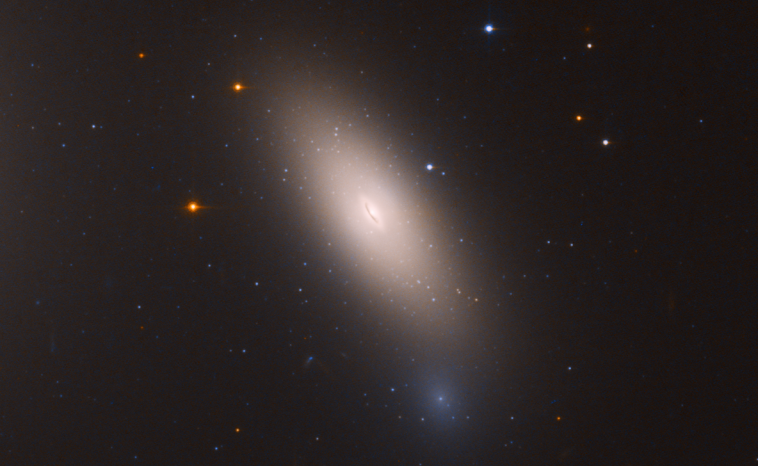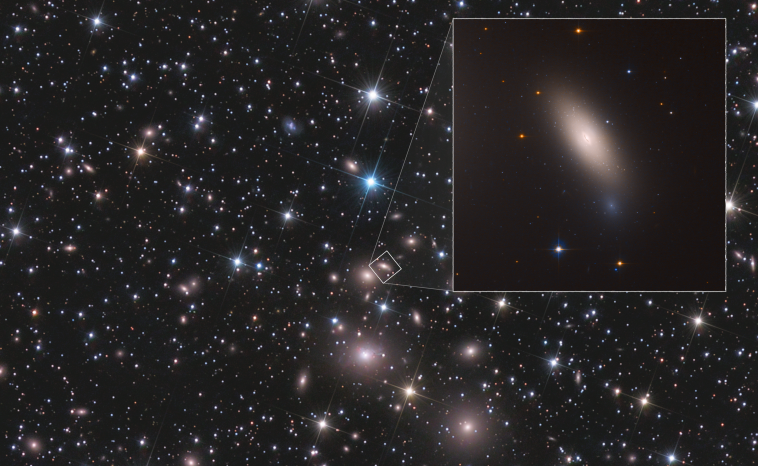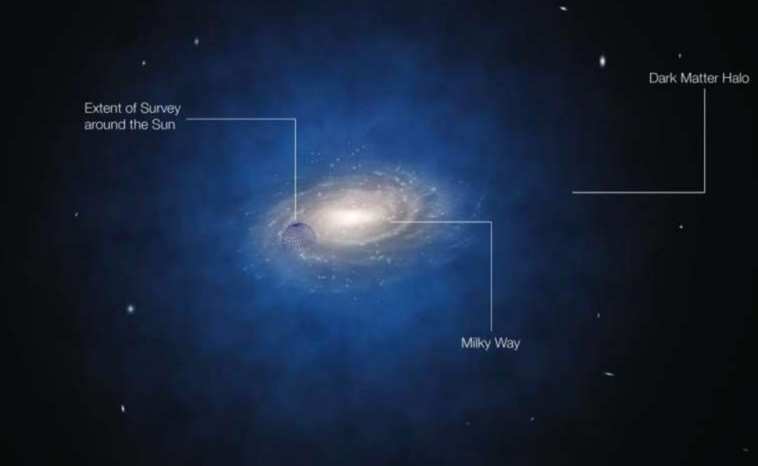What’s the Deal With Galaxy NGC 1277?

In this article, we’ll take a closer look at the fascinating NGC 1277 galaxy and examine some of its most intriguing features, including its surprising and unexplained lack of dark matter.
With an estimated 200 billion galaxies in the observable universe, it’s not surprising that many galaxies exhibit unique traits. However, few galaxies have quite as many quirks as NGC 1277. From an unexpected velocity and ancient stars to a hugely oversized black hole and a distinct lack of dark matter, there’s plenty about this curious heavenly body to consider. Join us as we take a deep dive into NGC 1277 and its bizarre features.
What Is NGC 1277?

Credits: NASA, ESA, and M. Beasley (Instituto de Astrofísica de Canarias)
Credits: NASA, ESA, and M. Beasley (Instituto de Astrofísica de Canarias)NGC 1277, categorised as a lenticular galaxy, is an intriguing anomaly in the vast cosmos. Located in the Perseus constellation, approximately 220 million light-years away, NGC 1277 is around 25,000 light-years wide. It’s populated by ancient stars, estimated to be approximately ten billion years old, with virtually no trace of younger stars. This intriguing phenomenon signifies that the galaxy has remained frozen, experiencing little to no star formation for billions of years. This curious absence of star formation activity, coupled with the galaxy’s exceptionally high stellar velocity – nearly twice that of our Milky Way – makes NGC 1277 a subject of intense study.
NGC 1277’s Black Hole
NGC 1277’s most extraordinary feature is perhaps the supermassive black hole at its centre, which accounts for an astonishing 14% of the galaxy’s mass – a proportion that vastly exceeds that found in most other galaxies. This fascinating, seemingly incompatible pairing defies conventional theories about the relationship between galaxies and their central black holes, prompting scientists to rethink existing models of galactic evolution.
Our current understanding suggests that the bigger the galaxy, the larger the black hole. However, NGC 1277, with its smaller size but disproportionately sizeable black hole, raises new questions about our understanding of these celestial enigmas.
NGC 1277 Vs the Milky Way

NASA Hubble Space Telescope, Public domain, via Wikimedia Commons
Credits: NASA, ESA, M. Beasley (Instituto de Astrofísica de Canarias), and P. KehusmaaDespite being just a tenth of the size of our home galaxy, the Milky Way, NGC 1277’s central black hole is about 1,000 times larger than Sagittarius A*, the supermassive black hole at the centre of the Milky Way. Indeed, NGC 1277’s black hole weighs in at an equivalent mass of 17 billion Suns! This unusual characteristic provides an intriguing study area for astrophysicists, shedding light on the possible variances in galactic formation and evolution processes.
NGC 1277 is also relatively undisturbed, having avoided significant mergers and retaining its original structure, offering a unique snapshot into the cosmos’ early epochs. Conversely, the Milky Way’s history is marked by numerous collisions and mergers, significantly influencing its current spiral structure, star distribution, and overall size. Astronomers believe that this may be due to the relative speeds of each galaxy, with the Milky Way travelling at around 1.3 million miles per hour and NGC 1277 travelling at a much faster 2 million miles per hour.
Not only does this increased velocity mean NGC 1277 is travelling too fast to merge with other galaxies it may encounter, but it also means the galaxy cannot collect the gases required to form new stars. Furthermore, the galaxy’s core remains too hot to sufficiently cool and condense, another vital step in star formation.
NGC 1277 and Dark Matter
Given its unique characteristics, NGC 1277 provides an intriguing case study for exploring the role of dark matter in galactic formation and evolution. Dark matter, an unseen and little-understood substance, is believed to constitute approximately 85% of all matter in the universe. Moreover, dark matter typically accounts for between 10% and 70% of the mass in any given galaxy. However, recent observations by researchers from the Instituto de Astrofísica de Canarias and the University of La Laguna suggest that in the case of NCG 1277, no more than 5% of its matter is dark. Discussing these findings, led researcher Sebastién Comerón explained, “This result does not fit in with the currently accepted cosmological models, which include dark matter.”
Traditional models suggest a correlation between the mass of dark matter in a galaxy’s halo and the size of its central black hole. However, NGC 1277’s enormous black hole, despite residing in a relatively modest-sized galaxy, suggests a departure from this link, raising intriguing questions about the role dark matter may have played in its formation. Astronomers from the IAC and ULL are currently considering two possible explanations for the lower-than-expected quantities of dark matter that NGC 1277 contains, including the idea that gravitational interactions with materials surrounding the galaxy cluster have stripped away much of the galaxy’s dark matter.
Are such galaxies more common than we currently believe? Could there be other factors at play in the formation of supermassive black holes? These are just a few of the questions that the study of NGC 1277 can help us answer, pushing us to further our understanding of the relationship between dark matter and black holes.
What Is Dark Matter?
Dark matter, as the name suggests, is a kind of matter that does not interact with electromagnetic radiation, making it invisible and hence ‘dark’. Even though we can’t see or directly measure it, we know it exists because of its gravitational effects on visible matter, including the stars and galaxies.
Swiss astronomer Fritz Zwicky first hypothesised the existence of dark matter in the 1930s. Zwicky noticed that galaxies in a distant cluster were moving faster than what could be accounted for by the visible matter alone. Since then, numerous observations have all pointed towards the existence of this invisible, mysterious form of matter. Although scientists have yet to pinpoint what dark matter is made of, it’s believed to be composed of undiscovered subatomic particles. Various experiments are underway to directly detect these particles and shed more light on the nature of dark matter, which remains one of the biggest mysteries in cosmology.
What Can We Learn From Relic Galaxies?
Relic galaxies, such as NGC 1277, offer an unrivalled glimpse into the distant past of our universe. They are like cosmic time capsules, having remained unchanged for billions of years. By studying them, we can gain insights into the conditions that were present when galaxies first began to form and evolve.
For instance, the unusual properties of NGC 1277 suggest that it formed in a different environment or underwent a unique evolution process. This could challenge our current understanding of galaxy formation and provide new perspectives. Furthermore, the unexpectedly large black hole at its centre may offer clues about how such supermassive black holes form and evolve. Notably, the black hole’s mass and its disconnect from the galaxy’s stellar content could indicate a different formation pathway, one that involves dark matter.
These revelations underscore the importance of continuing the study of such galaxies. Through further observation and analysis, we may uncover more about the elusive nature of dark matter and its role in cosmic evolution.
The OSR Star Finder App

The cosmos, with its myriad galaxies, stars, and celestial bodies, continues to enthral and perplex us. Our exploration of space, albeit in its infancy, has already revealed a far more complex and mysterious universe than we ever imagined. Tools such as the Hubble Space Telescope and the James Webb Space Telescope, coupled with advances in computational astronomy, enable us to venture further into the deep recesses of space, leading us to fascinating objects like NGC 1277.
While we continue to learn more about the distant reaches of the universe, why not take the opportunity to discover more about objects a little closer to home with the OSR Star Finder App? After downloading the app to your iOS or Android device, you can locate and learn facts about some of the fascinating stars, planets, and constellations in our galactic neighbourhood and even locate your own named star.


